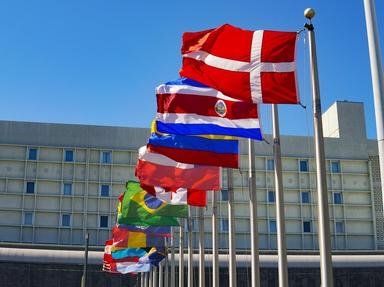Quiz Answer Key and Fun Facts
1. Birds I.
The eagle, a bird of prey that sits on the top of the food chain, features prominently on several national flags. From the options below which flag (they all contain eagles) contains a bald eagle?
2. Birds II.
A double-headed eagle has several meanings and is featured on several south eastern European nations' flags. In 2008, which "newish" nation replaced their "national flag" containing a double headed eagle with a flag depicting the country's outline and six stars?
3. Birds III
Some countries feature birds where the bird itself represents the country. All the following countries' flags contain a single bird. Which one contains a parrot?
4. Stars I
Stars feature prominently on many national flags. All the following flags feature a single star on the hoist (left hand) side of the flag. (Note Chile and Liberia both have single stars but are located in the canton of the flag). Which two flags have stars of the same colours?
5. Stars II
A few flags have multiple stars. The current incarnation of the Star-Spangled Banner is the obvious one with fifty; the Cook Islands flag has fifteen and Bosnia and Herzogovina's has nine (two are incomplete). The European Union flag is a dark blue background with a circle of five-pointed stars. Does the number of stars increase on the flag when a new country is admitted to the EU?
6. Stars III
Some nations in the Southern Hemisphere proudly have the Southern Cross constellation on their national flags. All the following countries' flags contain a Southern Cross but which one is "missing" a star?
7. Crosses I
A saltire is a diagonal cross-shape where the "cross-members" run from one corner to its opposite diagonal. There are a few saltire-type flags. Which one the following countries does *NOT* have a saltire for its flag?
8. Crosses II
The Nordic Cross type of flag is one where the vertical cross-member is offset and is closer to the hoist. This is a popular type of flag in Scandinavia and nearby countries and their various dependencies. Which two countries have flags that are the reverse of each other? (That is, which country has the cross the same colour as the field in the other and vice versa)?
9. Weapons I
Several African countries have weapons on their national flags as a reflection of their turbulent past. Each of the following African national flags feature at least one weapon but which flag is the only one that depicts a rifle?
10. Weapons II.
Some national flags also contain swords. All of the following flags contain swords though not necessarily as weapons. Which is the odd flag out by depicting a dagger as well as a sword?
Source: Author
1nn1
This quiz was reviewed by FunTrivia editor
trident before going online.
Any errors found in FunTrivia content are routinely corrected through our feedback system.

